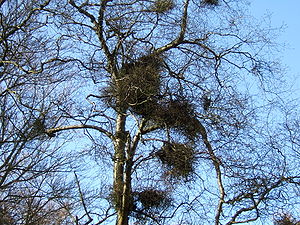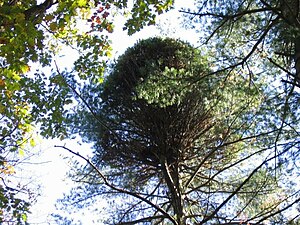
Back مكنسة الساحرة Arabic Laumšloustė BAT-SMG Ведзьміны мётлы Byelorussian Empelt de bruixa Catalan Čarověník Czech Hexenbesen (Biologie) German Σκούπα της μάγισσας Greek Escoba de bruja Spanish Tuulepesa Estonian جاروئک Persian



Witch's broom or witches' broom is a deformity in a woody plant, typically a tree, where the natural structure of the plant is changed. A dense mass of shoots grows from a single point, with the resulting structure resembling a broom or a bird's nest. It is sometimes caused by pathogens.
Diseases with symptoms of witches' broom, caused by phytoplasmas or basidiomycetes, are economically important in a number of crop plants, including the cocoa tree Theobroma cacao,[1] jujube (Ziziphus jujuba)[2] and the timber tree Melia azedarach.[3]
- ^ Purdy, L.H.; Schmidt, R.A. (1996). "Status Of Cacao Witches' Broom: Biology, Epidemiology, and Management". Annual Review of Phytopathology. 34 (1): 573–594. doi:10.1146/annurev.phyto.34.1.573. PMID 15012557.
- ^ Li Yun; Wang Yu; Tian Yanting & Sun Haoyuan (2001). "Advances in Tissue Culture and Eliminating of the Pathogeny of Witch Broom Disease(MLO) of Chinese Jujube".
{{cite journal}}: Cite journal requires|journal=(help) - ^ Gomez, G.G.; Conci, L.R.; Ducasse, D.A.; Nome, S.F. (1996). "Purification of the Phytoplasma Associated with China-tree (Melia azedarach L.) Decline and the Production of a Polyclonal Antiserum for its Detection". Journal of Phytopathology. 144 (9–10): 473–477. doi:10.1111/j.1439-0434.1996.tb00327.x.
© MMXXIII Rich X Search. We shall prevail. All rights reserved. Rich X Search